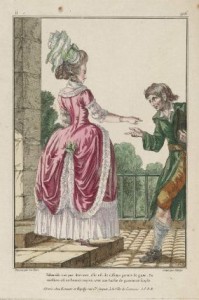
By Kendra Van Cleave
Over the past few years, Brooke Welborn and I have been intensively researching the robe à la polonaise. We found that the style had been confused with other dresses of the late eighteenth-century, most notably the robe à l’anglaise, both by academic researchers and historical costumers.
The results of our research have just been published as an article in Dress, the research journal of the Costume Society of America. Below is a summary of our findings, as well as information on how to get access to our published article, which has the full results.
About the Article
The citation for the article is:
Van Cleave, Kendra, and Brooke Welborn. “`Very Much the Taste and Various are the Makes’: Reconsidering the Late-Eighteenth-Century Robe à la Polonaise.” Dress 39, no. 1 (May 2013): 1-24.
Article abstract: The robe à la polonaise as worn in France and England in the late eighteenth century was a substantially different style from other fashionable gowns of the period, and was remarkably popular in its own right. In addition to the looped-up overskirt, the polonaise was distinguished by the robe cut without waist seam and inverted `V’ front opening. It was probably derived from the Polish robe called `kontusz,’ as well as the looped-up skirts of the robe à la française. Contemporaries regarded it as a more `natural’ style of dress in line with the Enlightenment, and it was thought to be most appropriate for wear by middle- and upper-class women of young to middle age. The style featured revivals in the 1790s and late nineteenth century.
Accessing the Full Article
Find a local library with a print copy of, or electronic access to, the journal Dress. WorldCat provides a list of libraries who subscribe to the journal.
Alternately, you can purchase a PDF of the article from Ingenta Connect.
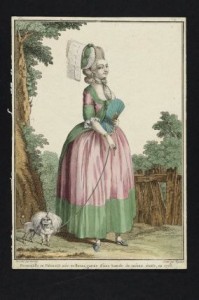
What Is the 18th Century Definition of a Polonaise?
The dress version — the robe à la polonaise (French/English; also called “polonese” or “poloneze” in English):
- Bodice and skirt of the robe are cut in one — no waist seam
- Robe has four pieces: two backs, and two fronts
- The skirt of the robe is usually looped up using two ribbons, tapes, or cords, forming three swags
- The center-front of the robe meets at the neckline, then slopes away in an inverted “V” shape towards the waist and into the skirt
- Inverted pleats emerged at the waist from the side-back and center-back seams, creating more fullness in the skirt
- The bodice of the robe usually has 1-3 pleats at the side back, which serves to fit the robe closer to the body
- Under the robe is worn a separate or false waistcoat, bodice, or stomacher
- The sleeves generally ended just below the elbow, usually with a cuff (called “sabot”)
What About Other Dresses Where the Skirts Are Looped Up?
These would not be considered to be a “polonaise.” The French term for any dress (e.g. a robe à l’anglaise, a robe à la française) with skirts looped up was “retroussée” (which means looped or pulled up); for example, a “robe à l’anglaise retroussée” (example). There does not appear to be any standard term used in English, where dresses were referred to having been worn “up” or “back.”
What About the “Zone” or Underbodice?
An underbodice effect was created by one of the following: a false waistcoat sewn into the side back and armscye seams, a separate waistcoat or bodice, or a stomacher. Note that the term “zone” does not appear to have any historical basis. The terms used in the period were waistcoat/veste, stomacher/pièce d’estomac, or corsage (bodice).
The Popularity of the Polonaise
The polonaise style was popular from about 1772 until about 1785, although we have found sources that suggest its origin was as early as 1767. It was likely to have been the most popular undress (informal) style of its time — roughly fifty percent of the fashion plates in the Gallerie des Modes depict the polonaise, while other leading styles were shown in only about ten percent of the plates. It was worn across the social spectrum, although sources suggest that it was considered more appropriate for young and early middle aged women. By the mid-1770s, it was fashionable enough to be worn at informal court balls in France and England.
How Do You Know?
We consulted a wide range of eighteenth century sources for our research. We systematically surveyed French and English fashion and women’s magazines, including L’Arlequin, ou Tableau de Modes (1798-99); Cabinet des Modes ou Les Modes Nouvelles (1785-86); Le Courier de la Mode (1768-69); Journal des Dames et des Modes (aka Costumes Parisiens) (1800-4); The Fashions of London & Paris (1798-1804); Gallerie des Modes et Costumes Français (1778-87); Gallery of Fashion (1794-1810); Journal de la Mode et du Gout (1790-3); Journal des Dames et des Modes (1798-9); The Ladies Magazine (1770-1810); Magasin des Modes Nouvelles (1787-9); Magazine à la Mode (1777); and New Lady’s Magazine (1789-95). We furthermore reviewed a large number of eighteenth-century works of art (paintings and drawings), personal writings (memoirs, diaries, and letters), and publications. Finally, we identified a number of extant (surviving) robes and jackets à la polonaise in museum collections, some of which we studied in-depth.
Extant Examples of the Polonaise
There are a number of surviving examples of robes and jackets à la polonaise in museums:
Others, not available online, are cited in our article.
Are There Any Published Patterns for the Polonaise?
Norah Waugh includes two patterns in her book The Cut of Women’s Clothes. The first is for a robe à la polonaise at the Victoria & Albert Museum. The other garment, which she calls a “polonaise style jacket,” is more likely to be some kind of redingote.
Kendra is working on a book related to this research that will include scaled patterns for several robes and jackets a la polonaise… more details when they’re available!
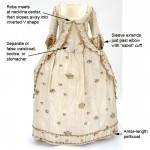
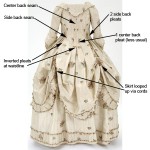
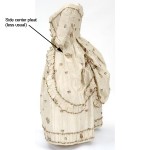



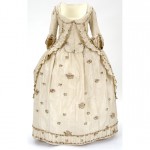
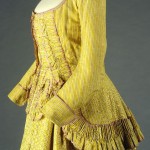
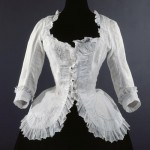
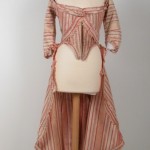
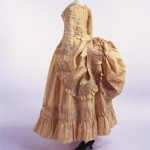
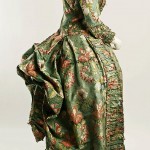
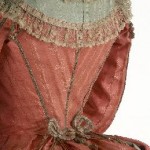


Thank you for the terrific research. It’s off to Worldcat I go for the full treatment.
Bravo!
Very best,
Natalie
Thanks so much for writing up this summary! It’ll keep me sated until I can finagle a university copy 🙂
Congratulations!!! And thank you so much for sharing this summary! I can’t wait to read the rest!
This is fantastic! I can’t *wait* for your book!
Congratulations on having this piece of research published! I can’t wait for your forthcoming book!
This is amazing! What a terrific and vital piece of research this is, and your hard work and investigative powers are certainly evident! Kudos to you!
Although I’ve heard you lecture on this, it’s great to see it spelled out, and the examples of extant garments are beautiful and informative. Congrats on the publication and thanks so much for sharing!
Superb article!
I’ve been trying to preach about the “real” polonaise for a few years and it’s so wonderful to now have a reputable source to refer to!
Go Kendra!!
Can’t wait for the book!
Such an amazing job, thanks very much for sharing the information. I’m looking forward for Kendra’s book!
I was looking for the 1870’s revival of the polonaise, but this is still good.
Hi, I saw this and thought you could add it to your references. The Germans disguised between the Polonaise and the retroussée also. This German Almanac has fashion plates in it. I wish the other plates were shown too.
http://mywabilife.blogspot.com/2011/04/18th-century-german-almanac.html
Great Research. Will be useful in my story I’m writing; good work.
I purchased a pattern – Wingeo #207 Late 18th C. Robe a L’anglaise. It is really unlike any English gown pattern I’ve seen and the construction seems nearly identical to your description of polonaise with a few exceptions. It gets you really close. I wish I would have read this before I got this far in construction; I would have changed a couple things 🙂
I went to a great lecture at a museum recently – but I was hoping to get insight into what the difference is between a Brunswick jacket and a Robe a la Francaise in 18th century fashion. Would love any resources you may be able to share
Sure! The main difference is the Brunswick has long sleeves and a hood. Check out my research post on Brunswicks: http://demodecouture.com/18th-century-brunswicks-and-jesuits/